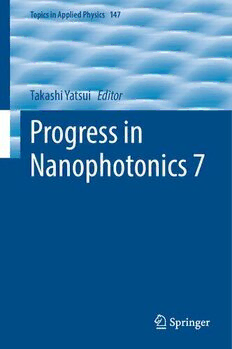
Progress in Nanophotonics 7 PDF
Preview Progress in Nanophotonics 7
Topics in Applied Physics 147 Takashi Yatsui Editor Progress in Nanophotonics 7 Topics in Applied Physics Volume 147 SeriesEditors YoungPakLee,Physics,HanyangUniversity,Seoul,Korea(Republicof) DavidJ.Lockwood,MetrologyResearchCenter,NationalResearchCouncilof Canada,Ottawa,ON,Canada PaoloM.Ossi,NEMAS—WIBIDILab,PolitecnicodiMilano,Milano,Italy KaoruYamanouchi,DepartmentofChemistry,TheUniversityofTokyo,Tokyo, Japan Topics in Applied Physics is a well-established series of review books, each of which presents a comprehensive survey of a selected topic within the domain of applied physics. Since 1973 it has served a broad readership across academia and industry,providingbothnewcomersandseasonedscholarseasybutcomprehensive accesstothestateoftheartofanumberofdiverseresearchtopics. Editedandwrittenbyleadinginternationalscientists,eachvolumecontainshigh- qualityreviewcontributions,extendingfromanintroductiontothesubjectrightup tothefrontiersofcontemporaryresearch. Topics in Applied Physics strives to provide its readership with a diverse and interdisciplinarycollectionofsomeofthemostcurrenttopicsacrossthefullspectrum ofappliedphysicsresearch,includingbutnotlimitedto: (cid:129) Quantumcomputationandinformation (cid:129) Photonics,optoelectronicsanddevicephysics (cid:129) Nanoscalescienceandtechnology (cid:129) Ultrafastphysics (cid:129) Microscopyandadvancedimaging (cid:129) Biomaterialsandbiophysics (cid:129) Liquidsandsoftmatter (cid:129) Materialsforenergy (cid:129) Geophysics (cid:129) Computationalphysicsandnumericalmethods (cid:129) Interdisciplinaryphysicsandengineering Wewelcomeanysuggestionsfortopicscomingfromthecommunityofapplied physicists, no matter what the field, and encourage prospective book editors to approach us with ideas. Potential authors who wish to submit a book proposal shouldcontactZachEvenson,PublishingEditor: [email protected] TopicsinAppliedPhysicsisincludedinWebofScienceandindexedbyScopus. Takashi Yatsui Editor Progress in Nanophotonics 7 Editor TakashiYatsui DepartmentofElectricalandElectronic InformationEngineering ToyohashiUniversityofTechnology Toyohashi,Aichi,Japan ISSN 0303-4216 ISSN 1437-0859 (electronic) TopicsinAppliedPhysics ISBN 978-3-031-16517-7 ISBN 978-3-031-16518-4 (eBook) https://doi.org/10.1007/978-3-031-16518-4 ©TheEditor(s)(ifapplicable)andTheAuthor(s),underexclusivelicensetoSpringerNature SwitzerlandAG2022 Thisworkissubjecttocopyright.AllrightsaresolelyandexclusivelylicensedbythePublisher,whether thewholeorpartofthematerialisconcerned,specificallytherightsoftranslation,reprinting,reuse ofillustrations,recitation,broadcasting,reproductiononmicrofilmsorinanyotherphysicalway,and transmissionorinformationstorageandretrieval,electronicadaptation,computersoftware,orbysimilar ordissimilarmethodologynowknownorhereafterdeveloped. Theuseofgeneraldescriptivenames,registerednames,trademarks,servicemarks,etc.inthispublication doesnotimply,evenintheabsenceofaspecificstatement,thatsuchnamesareexemptfromtherelevant protectivelawsandregulationsandthereforefreeforgeneraluse. Thepublisher,theauthors,andtheeditorsaresafetoassumethattheadviceandinformationinthisbook arebelievedtobetrueandaccurateatthedateofpublication.Neitherthepublishernortheauthorsor theeditorsgiveawarranty,expressedorimplied,withrespecttothematerialcontainedhereinorforany errorsoromissionsthatmayhavebeenmade.Thepublisherremainsneutralwithregardtojurisdictional claimsinpublishedmapsandinstitutionalaffiliations. ThisSpringerimprintispublishedbytheregisteredcompanySpringerNatureSwitzerlandAG Theregisteredcompanyaddressis:Gewerbestrasse11,6330Cham,Switzerland Foreword Asthefirstexample,recentadvancesinphotonicsystemsdemanddrasticincreases inthedegreeofintegrationofphotonicdevicesforlarge-capacity,ultrahigh-speed signaltransmissionandinformationprocessing.Devicesizehastobescaleddown tonanometricdimensionstomeetthisrequirement,whichwillbecomeevenmore strict in the future. As the second example, photonic fabrication systems demand drastic decreases in the size of the fabricated patterns for assembling ultra-large- scaleintegratedcircuits.Theserequirementscannotbemetevenifthesizesofthe materialsaredecreasedbyadvancedmethodsbasedonnanotechnology.Itisessen- tial to decrease the size of the electromagnetic field used as a carrier for signal transmission,processingandfabrication.Suchadecreaseinthesizeoftheelectro- magneticfieldbeyondthediffractionlimitofthepropagatingfieldcanberealized in optical near fields. Nanophotonics, a novel optical technology that utilizes the opticalnearfield,wasproposedbyM.Ohtsu(theeditorofthismonographseries)in 1993inordertomeettheserequirements.However,itshouldbenotedthatthetrue natureofnanophotonicsinvolvesnotonlyitsabilitytomeettheaboverequirements. It is also its ability to realize qualitative innovations in photonic devices, fabrica- tiontechniques,energyconversionandinformationprocessingsystemsbyutilizing novel functions and phenomena made possible by optical near-field interactions, which are otherwise impossible as long as conventional propagating light is used. Basedoninterdisciplinarystudiesoncondensedmatterphysics,opticalscienceand quantumfieldtheory,nano-materialsandopticalenergytransferinthenanometric regimehavebeenextensivelystudiedinthelasttwodecades.Throughthesestudies, novel theories on optical near fields have been developed and a variety of novel phenomenahavebeenfound.Theresultsofthisbasicresearchhavebeenappliedto developnanometer-sizedphotonicdevices,nanometer-resolutionfabrication,highly efficient energy conversion and novel information processing, resulting in qualita- tiveinnovations.Furtheradvancementintheseareasisexpectedtoestablishnovel optical sciences in the nanometric space, which can be applied to further progress innanophotonicsinordertosupportthesustainabledevelopmentofpeople’slives all over the world. This unique monograph series entitled Progress in Nanopho- tonicsinSpringerSeriesinNano-opticsandNanophotonicsisbeingintroducedto v vi Foreword reviewtheresultsofadvancedstudiesinthefieldofnanophotonicsandcoversthe mostrecenttopicsoftheoreticalandexperimentalinterestinrelevantfields,suchas classicalandquantumopticalsciences,nanometer-sizedcondensedmatterphysics, devices, fabrication techniques, energy conversion, information processing, archi- tecturesandalgorithms.Eachchapteriswrittenbyleadingscientistsintherelevant field.Thus,thismonographserieswillprovidehigh-qualityscientificandtechnical information to scientists, engineers and students who are and will be engaged in nanophotonicsresearch.Ascomparedwiththepreviousmonographseriesentitled ProgressinNano-Electro-Optics(editedbyM.Ohtsu,publishedinSpringerSeries in Optical Science), this monograph series deals not only with optical science on the nanometer scale, but also its applications to technology. I am grateful to Dr. C. Ascheron of Springer-Verlag for his guidance and suggestions throughout the preparationofthismonographseries. Tokyo,Japan MotoichiOhtsu Preface to Volume VII Thisbookfocusesonvariousandmutuallyrelatedtopicsinnanophotonicswritten by the world’s leading experts. Following the elaboration of the idea of nanopho- tonics, much theoretical and experimental work has been carried out, and several novelphotonicdevices,high-resolutionfabrication,highlyefficientenergyconver- sionand novel information processing were developed in these years. Novel theo- retical models describing the nanometric light-matter interaction were also devel- oped. For reviewing and demonstrating this recent progress in nanophotonics, this bookfocusesonvariousandmutuallyrelatedtopicsinnanophotonicswrittenbythe world’sleadingexperts.Thefirstchapterisdevotedtodescribingtheoreticalstudies onthephotoexcitationofheterostructurescontainingananomaterialusingthefirst- principlescomputationalresults.Thesecondchapterdescribesabriefoverviewof localized surface plasmon resonance-based applications, including solar cell and photocatalyst. The third chapter describes the development of photomaterials for applications in optics and nanotechnologies. The fourth chapter describes recent progressinhybridintegrationofquantum-dotsingle-photonsourcesonSitowards scalable Si quantum photonics. The last chapter describes the hybrid quantum photonics based on color centers in nanodiamonds and Si N -photonics towards 3 4 a technology platform with applications in quantum information processing and quantum information distribution. This volume is a valuable resource for readers andfuturespecialistsinnanophotonics. Toyohashi,Japan TakashiYatsui vii Contents 1 First-PrinciplesCalculationofPhotoexcitedElectronDynamics ofNanostructures .............................................. 1 KenjiIidaandMasashiNoda 1.1 Introduction ............................................... 1 1.2 TheoryAboutPhotoexcitationofNanoparticle .................. 3 1.3 SimulationofPhotoexcitedElectronDynamics ................. 5 1.4 GoldNanocluster ........................................... 7 1.5 Gold-ThiolateNanocluster ................................... 11 1.6 Near-FieldExcitationofSilicon .............................. 18 1.7 SilverNanocluster/TitaniaHeterostructure ..................... 24 1.8 Summary .................................................. 32 1.9 Appendix ................................................. 33 References ..................................................... 33 2 Nanomaterials for Localized Surface Plasmon Resonance-RelatedOpticalFunctionalities ....................... 37 GoKawamuraandAtsunoriMatsuda 2.1 LocalizedSurfacePlasmonResonance ........................ 37 2.1.1 Shape-ControlledPlasmonicNanomaterials .............. 38 2.1.2 Assembly-ControlledPlasmonicNanomaterials .......... 48 2.2 VariousOpticalFunctionalitiesRelatedtoLocalizedSurface PlasmonResonance ......................................... 51 2.2.1 SurfaceEnhancedRamanScatteringSubstrates .......... 51 2.2.2 Polarizers ........................................... 52 2.2.3 HologramMemoryMedia ............................. 55 2.2.4 SolarCells .......................................... 59 2.2.5 Photocatalysts ....................................... 62 2.3 SummaryandOutlook ...................................... 67 References ..................................................... 67 ix x Contents 3 NanochemistrybyThermoplasmonicEffects ...................... 71 CélineMolinaro,AmineKhitous,LaurentNoel,andOlivierSoppera 3.1 Introduction ............................................... 71 3.2 ThermoplasmonicsandTemperature .......................... 76 3.2.1 HeatPowerGeneratedinNPs .......................... 76 3.2.2 TemperatureGenerationinNPs ........................ 78 3.2.3 CollectiveEffects .................................... 79 3.2.4 PulsedIllumination ................................... 80 3.3 ThermoplasmonicsandChemistry ............................ 82 3.3.1 DrivenChemicalReactionandCatalysis ................ 82 3.3.2 PolymerChemistry ................................... 84 3.3.3 CuringInorganic MaterialsPrepared viaSol-Gel Chemistry ........................................... 88 3.4 Conclusion ................................................ 89 References ..................................................... 89 4 Hybrid Integration of Quantum-Dot Non-classical Light SourcesonSi .................................................. 93 RyotaKatsumi, YasutomoOta, SatoshiIwamoto, andYasuhikoArakawa 4.1 Introduction ............................................... 93 4.2 DeviceDesignforNear-UnityCouplingofQDEmission intoSiPhotonicWaveguide .................................. 96 4.3 HybridIntegrationofQDSPSsonSi .......................... 97 4.3.1 TransferPrinting ..................................... 97 4.3.2 ProcedureofIntegratingQDSPSonSiCMOSChip BasedonTP ........................................ 98 4.3.3 Evaluation of Integrated QD SPS on CMOS Si Waveguide .......................................... 103 4.4 In-SituWavelengthControlofQDSingle-PhotonSource onSiCMOSChip .......................................... 108 4.4.1 DeviceStructureforOn-ChipSpectralTuningofQD SPS ................................................ 109 4.4.2 FabricationofInvestigatedDeviceStructure ............. 109 4.4.3 OpticalCharacterizationoftheFabricatedDevice ......... 111 4.4.4 SpectralMatchingBetweenTwoDissimilarIntegrated QDSources ......................................... 114 4.5 Summary .................................................. 117 References ..................................................... 117 5 HybridQuantumNanophotonics—InterfacingColorCenter inNanodiamondswithSi N -Photonics .......................... 123 3 4 AlexanderKubanek, AnnaP.Ovvyan, LukasAntoniuk, NiklasLettner,andWolframH.P.Pernice 5.1 Introduction ............................................... 123 5.2 PotentialPathwaysTowardsHybridQuantumPhotonics ......... 124
